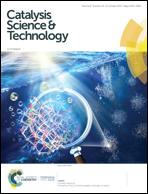An MOF-derived copper@nitrogen-doped carbon composite: the synergistic effects of N-types and copper on selective CO2 electroreduction†
Abstract
The development of Cu-based complex electrocatalysts can lead to the facile realization of high activity and selectivity for reducing CO2 to multi-carbon hydrocarbons; exploring the synergistic effect between Cu and other materials may help in designing highly efficient catalysts. This paper reports an impact factor for synergistic effects between Cu and nitrogen-doped carbon (NC) supports by comparing CO2 reduction reaction (CO2RR) performances on MOF-derived copper@nitrogen-doped carbon (Cu–NC) catalysts obtained by the calcination of N-containing benzimidazole-modified Cu-BTC (1,3,5-benzenetricarboxylic acid) MOFs (BEN-Cu-BTC) at different temperatures. Different types of Cu–NC samples show the N species- and content-dependent catalysis for the highly selective electroreduction of CO2 to C2 products. The characterization and experimental results indicate that the high contents of pyrrolic-N and Cu–N species formed at the annealing temperature of 400 °C can facilitate the C2-product generation on a Cu surface, with the reaction rates and Faradaic efficiencies (FEs) for ethylene and ethanol being rethylene = 5.38 μmol m−2 s−1 (FE = 11.2%) and rethanol = 8.83 μmol m−2 s−1 (FE = 18.4%) at −1.01 V (vs. reversible hydrogen electrode (RHE)), respectively. However, excess graphitic-N and oxidized-N on the Cu surface result in considerable H2 evolution and a rapid decrease in the CO2RR activity. These may occur due to the differences in the adsorption and valence state affecting the Cu–NC interactions. These results indicate that the catalytic activity on MOF-derived Cu–NC catalysts can be controlled by the N-type species that dominates at the corresponding annealing temperature, offering a new tack for designing highly selective complex catalysts since the electrocatalytic performance of the Cu–NC catalysts remains stable over 8 h.



 Please wait while we load your content...
Please wait while we load your content...